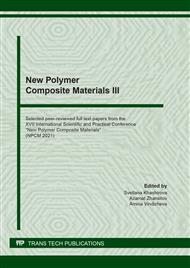[1]
Electronic resourcehttps://www.refinitiv.ru/blog/market-insights/rynok-polipropilena-itogi-2019-i-trevozhnye-ozhidanija/.
Google Scholar
[2]
Cherian, E. and K. Jayachandran, 2011. Microbial Degradation of Natural Rubber Latex by a Novel Species of Bacillus sp. SBS25 Isolated from Soil. International Journal of Environmental Research, 4 (3): 599-604.
Google Scholar
[3]
Berekaa, M. M., 2009. Colonization and microbial degradation of polyisoprene rubber by Nocardioform actinomycete Nocardia sp. strain MBR. Biotechnology, 3 (5): 234-239.
DOI: 10.3923/biotech.2006.234.239
Google Scholar
[4]
Roy, R.V., M. Das, R. Banerjee and A.K. Bhowmick, 2011. Comparative studies on crosslinked and uncrosslinked natural rubber biodegradation by Pseudomonas sp. Bioresource Technology, 97 (18): 2485-2488.
DOI: 10.1016/j.biortech.2005.09.024
Google Scholar
[5]
Chengalroyen, M.D. and E. Dabbs, 2012. Characterization of rubber degrading isolates. The Journal of Microbiology, Biotechnology and Food Sciences, 2 (3): 872-885.
Google Scholar
[6]
Warneke, S., M. Arenskotter, K.B. Tenberge, and A. Steinbuchel, 2007. Bacterial degradation of poly (trans-1,4-isoprene) (gutta percha). Microbiology, 2 (153): 347-356. 7] Kalinenko, V.O., 2013. The role of actinomyces and bacteria in decomposing rubber. Mikrobiologiia 17: 119-128.
DOI: 10.1099/mic.0.2006/000109-0
Google Scholar
[8]
Borel, M., A. Kergomard and M.F. Renard, 2012. Degradation of natural rubber by Fungi Imperfecti. Agricultural and Biological Chemistry, 46: 877-878.
DOI: 10.1080/00021369.1982.10865189
Google Scholar
[9]
G. Nayanashree. 2008. The breakdown of rubber polymers by microorganisms. International Biodeterioration Bulletin, 18: 31-36.
Google Scholar
[10]
Shah, A.A. Biodegradation of natural and synthetic rubbers: A review / A.A. Shah, F. Hasan, Z. Shah, N. Kanwal, S. Zeb // International Biodeterioration & Biodegradation, 2013. - Vol. 83.145-157.
DOI: 10.1016/j.ibiod.2013.05.004
Google Scholar
[11]
Ghosh, S.K. Study of microbes having potentiality for biodegradation of plastics / S.K. Ghosh, S. Pal, S. Ray // Environ Sci Pollut Res., 2013. – No. 20.–. 4339–4355.
DOI: 10.1007/s11356-013-1706-x
Google Scholar
[12]
Smirnov, V.F. Micromycete destruction of composite materials based on natural and synthetic polymers / V. F. Smirnov, A. E. Mochalova, O. N. Smirnova, E. A. Zakharova, D. V. Kryazhev, L. A. Smirnova // Povolzhsky ecological journal, 2011. –№ 4. - P. 537-541.
Google Scholar
[13]
Varyan I. Physical-Mechanical Properties of Polyethylene-Natural Rubber Blends / I. Varyan, E. Mastalygina, N. Kolesnikova, A. Popov // Journal of Physics: Conference Series, (2018).
DOI: 10.1088/1742-6596/1129/1/012036
Google Scholar
[14]
Kolesnikova, N.N. Biodegradable compositions of polyethylene with natural rubber / N.N. Kolesnikova, E.E. Mastalygina, I.A. Varyan, A.A. Popov // Abstracts of the conference Medical and Bioorganic Chemistry,. - 2017.S. 583-584.
DOI: 10.1063/1.5045981
Google Scholar
[15]
Varyan, I.A. Analysis of deformation and strength properties and patterns of destruction of composite films based on polyethylene and natural rubber / I.A. Varyan, E.E. Mastalygina, N.N. Kolesnikova, AA Popov // Abstracts of the conference Advanced materials with a hierarchical structure for new technologies and reliable structures., - 2017. –S. 111-112.
DOI: 10.1063/1.5013907
Google Scholar
[16]
Krutko E.T. Technology of biodegradable polymeric materials: teaching aid / E. T. Krutko, N. R. Prokopchuk, A. I. Globa. - Minsk: BSTU, 2014 .-- 105 p.
Google Scholar
[17]
Yusupov R.R., V.V. Yanov, L.A. Zenitova Composite materials based on polypropylene and natural rubber/ R.R. Yusupov, V.V. Yanov, L.A. Zenitova// Technical Bulletin University 2017, T.20, No. 21 P 60-63.
DOI: 10.4028/www.scientific.net/kem.899.759
Google Scholar


